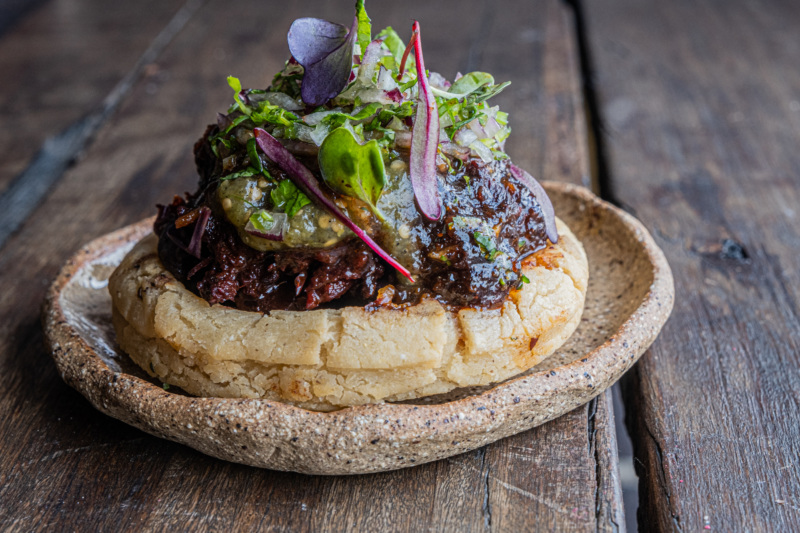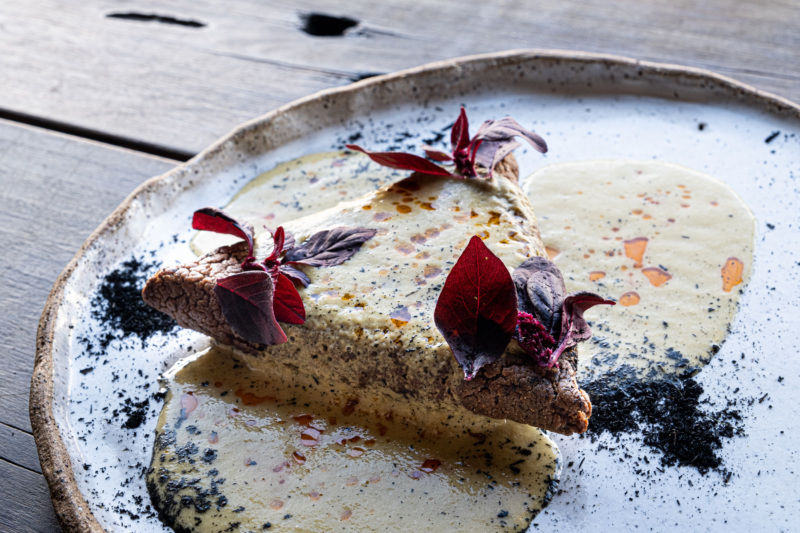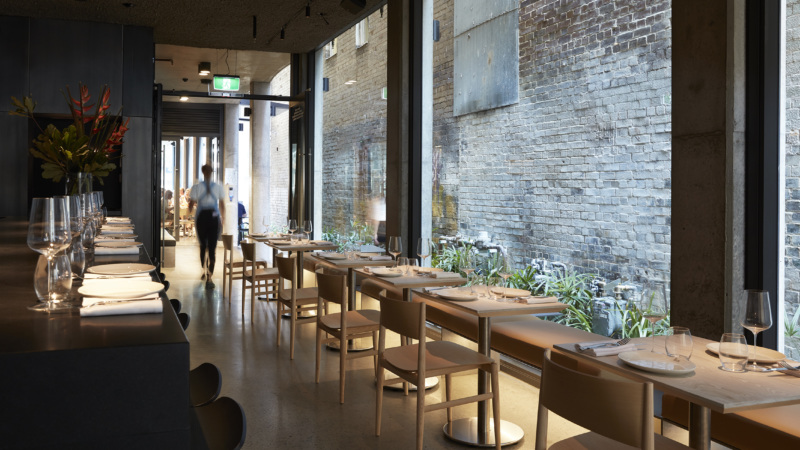
Three Dishes at Maíz in Newtown Made With One Transformative Ingredient
Juan Carlos Negrete was looking for a portal to his Mexican roots, but he couldn’t find it in any Sydney restaurant. Sure, there were tacos everywhere – “I guess from a business perspective, it’s the quickest, easiest way to do Mexican food,” he says – but the chef couldn’t detect a meaningful sense of home in the menus he looked at.
So, he eventually built that sense of home through Maíz, which began as a Summer Hill market stall in mid-2020. Along with partner Freija Brandie, sister Marissa Negrete and brother-in-law Carlos Levet, they wanted to show that Mexican cuisine was far richer and more wide-ranging than tacos alone.
- How Izgara in Potts Point Channels Istanbul’s Legendary Grills, in Five Dishes
- “I Don’t Want To Do Green Curry.” At Viand, Annita Potter Forges Her Own Path in Thai Cuisine
- The Resy Guide to The Best Restaurants in Potts Point
- Pablo Galindo Vargas Helped Shape Mexican Cuisine in Australia. But He Isn’t Done Yet.
“We wanted to make a statement about what Mexican food can be, which is why we focused everything on the foundation of corn,” he says.
That statement began with sopes, the “corn-based tartlets” they sold at markets. They expanded it further with chilaquiles (a breakfast staple and hangover cure that’s banked with corn chips) and tlacoyos (shaped from maize and blanketed with toppings, this dish dates back to the first major civilisation in Mexico, around a thousand years ago). Both were fixtures on Maíz’s brunch menu when it launched its permanent Newtown eatery last year.
And since switching to dinner services only, Maíz’s corn fixation has gotten a little tipsy, too. “We started fermenting our own corn to make what in Colombia is called chicha, but in Mexico is called tejuíno,” he says. “Even our whisky is made out of heirloom varieties of corn.”
Maíz (pronounced ‘my-iz’) is named after the Spanish word for the ingredient, after all, and the Indigenous Taíno people considered it to be a life-sustaining force. It’s something you’re reminded of from the very moment you turn up at the restaurant – you’re welcomed with a complimentary bowl of spiced popcorn, dusted in morita chillies and sticky with salted honey.
Sure, popcorn is ubiquitous as the (overpriced) candy bar option at the movies, but its inclusion here goes far beyond that. “It’s actually a product that some Indigenous communities use in ceremonies in festivities,” says Negrete.
“Even though the foundation [of Maíz] is one single grain, it’s quite versatile and it’s very exciting to use all these varieties of corn.”
Here are three dishes from Maíz’s menu that demonstrate the wide-ranging flair and power of this fundamental ingredient:


Sope de Jamaica
This hibiscus sope has been on the menu since the very first market stall. “It has a very special place in our heart,” says Negrete. It also perfectly distills Maíz’s aims in a few memorable bites: its traditional outlines allow the local Mexican community to connect with it, but the sope has also been vividly remixed to reflect Sydney’s multicultural landscape, its community of local producers, as well as today’s no-waste attitude to sustainability.
“Hibiscus is heavily consumed in Mexico as a cordial water,” Negrete says. But the flower is often thrown out after flavouring the drink. The chef gives it a second life by cooking it in a way that echoes tacos al pastor – the spit-roasted pork and pineapple taco introduced to Mexico by the Lebanese community.
“We slow-cook the hibiscus flower and we braise it as well, in a way that pork would be,” he says. The additional flavours originally came from Maíz’s fellow 2020 market stallholders – Drunken Sailor’s pineapple jam with rum and coconut and Mama Liu’s northwestern Chinese chilli oil – but nowadays, Maíz makes its own 10-chilli-oil to spice up the sope. It’s topped with salsa verde and garnished in a familiar way. “In every taqueria in Mexico, you basically have a bowl of onion and a bowl of coriander and you sprinkle that on top,” he says. But this a very Sydney creation, too – it’s highly compatible with Maíz’s Newtown setting, given the sope’s vegan status and the suburb’s long history of accommodating meat-free dining.
“I’m extremely excited that it’s a plant-based product, that it’s a gluten-free product and it seems to fit in perfectly with the culture of Newtown and the culture of Sydney,” he says. “I love it.”


Tetela de Huitlacoche
“Nahuatl is the language of Indigenous Mexicans, it was the most spoken language in Mexico,” says Negrete. Knowing that helps you decode what a tetela is – it’s derived from Nahuatl words for ‘mountain’ and ‘abundance’.
“It’s in one way representing the mountain, this triangular shape,” he says. “I couldn’t resist putting in on the menu and playing with it.”
To him, the angular shape – reflecting mountain peaks – perfectly captures the essence of the dish to him.
“[Corn] grows everywhere in Mexico, but I have memories of driving through the hills of Mexico and just seeing just corn as long as my sight could see – up the mountains and everything.” He recalls visiting remote communities high on the slopes, and being stunned by the effort of farmers.
“I was just surprised how they could grow corn in such steep conditions,” he says. “They are just a few things that come into my mind when I’m building dishes and I’m trying to build something that reflects that in our culture.”
Like the hibiscus-flavoured pastor, this dish is vegan, too. Its star ingredient is huitlacoche, aka corn truffle, “a black fungus which grows on corn during the rainy season”, he says. “It’s incredibly tasty and delicious. I use that to fill the tetela and on top, I dress it with a sweet corn espuma and we garnish it with corn husk ash, so it’s a bit like when you think of those fine-dining restaurants where they do beetroot five ways or strawberry five ways.”
For the chef, it was all about maxing out one ingredient.
“How can we make a dish that is corn filled with corn, topped with corn and garnished with corn?” he asks and laughs.


Uchepo with bottlebrush honey, vanilla chantilly and fermented salted strawberries
For months, the strawberry-dusted buñuelo was a highlight of Maíz’s dessert menu. It was visually striking – it looked like a giant flower-shaped pretzel – and it was powered by childhood memories and the buñuelo’s joyful association with Christmas and other festivities. “People make them when there is going to be a party,” says the chef.
“We’re actually shifting towards changing that dish – that was the only dish on the menu that didn’t allow us to call ourselves a fully gluten-free restaurant,” he says. Not only was it wheat-based, it didn’t feature Maíz’s namesake ingredient, either.
So it’s being replaced with a sweet corn tamale, aka the uchepo.
But the new dessert isn’t exactly performing a systematic hard-drive wipe, either. It’s keeping key features of the buñuelo – like the fermented strawberries and the bottlebrush honey it was served with. The honey is sourced by a friend who is a professional apiarist. “He harvests the honey from Lane Cone National Park,” says the chef. It’s another way Maíz keeps to its brief of serving recognisably Mexican food, while paying tribute to its surroundings (in this case, a tranquil site that’s home to eucalypt forests, ancient Aboriginal sites and five-metre-high grass trees).
Lee Tran Lam is a writer, podcaster, and editor of New Voices on Food, a Diversity In Food Media anthology showcasing under-represented Australian talent. Her work has been published in The Guardian, Rolling Stone, Gourmet Traveller, and SBS Food. Follow her on Twitter and Instagram. Follow Resy, too.















